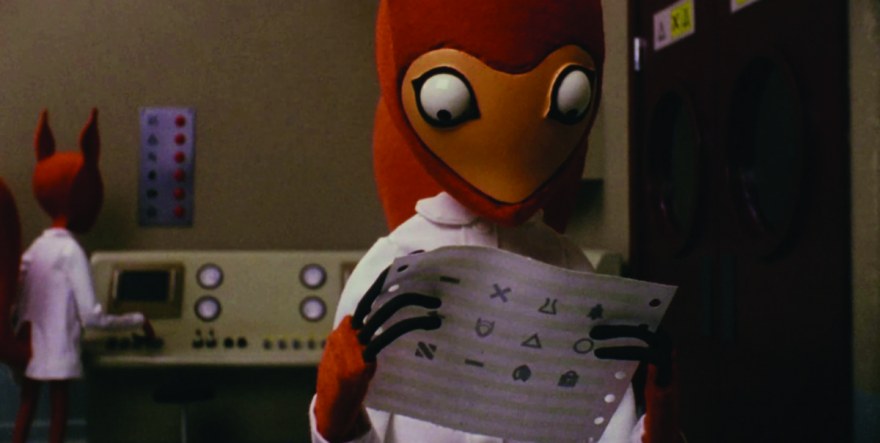Night cap with Squirrel Island
Interview with Astrid Goldsmith, director of Squirrel Island
Can you tell us a bit more about your background in animation and your specific “style”?
I taught myself to animate when I was 12 with an old Super-8 camera, I used to make plasticine models and backdrops from cereal packets, it was pretty lo-fi! Super-8 film came with a process-paid envelope, so you had to post the completed film off to a lab in Holland, then wait in agony for a month before seeing the results, but it was so exciting when the processed film arrived on the doormat. I carried on using film – both 8mm and 16mm – until I did my MA in animation, where I used digital capture software and video assist for the first time, which made me seriously fall out of love with animation! I was so used to the uninterrupted focus of shooting on film, where you have to keep the whole movement in your head and just concentrate on the performance without checking your progress on a screen. Shooting ”blind” on film allows a slightly dangerous element of risk and improvisation, if things go wrong mid-shot, you just have to keep going and sometimes the results can surprise you. I think my ”style” has grown out of this process, it’s gleefully imperfect! All of my favourite animators (Harryhausen, Starevich, Trnka, Pojar, Postgate) were from an era when everything was shot on film with lots of in-camera inventiveness, and there is something so tactile and beautiful and “other” about their characters’ movement and expression, it’s real cinematic magic.
What motivated to pick squirrels and acorns to tell this parable?
I wanted to find a way to express my concern about the way government policy impacts on innocent lives as well as the natural world, and to my mind, there are strong parallels between the politics surrounding squirrels and the politics surrounding immigration. In the aftermath of the 7/7 bombings, there was a noticeable increase in fear and prejudice in the city, particularly on the Underground. During this period, on my morning tube commute I kept reading newspaper articles about the impact invasive species are having on the environment and on British native species, and those articles were always illustrated with pictures of really cute red squirrels. Native red squirrels have become the endangered species’ poster child, probably because they are more photogenic than other endangered species (poor old brown trout), and maybe also due to the popularity of anthropomorphic red squirrel characters like Tufty and Squirrel Nutkin. Conversely, the grey squirrel is constantly painted as a demon interloper, a carrier of disease and a destroyer of the natural order, even though we introduced the species into Britain in the 1800s. I was interested in the way we decide between “good” and ”bad” animals, and the policies we implement as a result. When I visited the Isle of Wight (where they have eradicated grey squirrels to protect the reds) and saw all of the red squirrel propaganda and anti-grey signage, it reminded me of dystopian 70s sci-fi movies and I kept imagining what would happen if a plucky grey squirrel was trapped in that kind of environment. Acorns are the natural prey of grey squirrels, so I thought it would make sense if the red squirrels exploited this in their dastardly plan.
[Spoiler alert] What do you hope / think the audience would make of the ending?
We only know what we see – that Dot (the grey squirrel) is given a reprieve by the red squirrel cadets after she saves one of them from drowning, and then goes on to set up a clean-up operation with Mr Acorn to round up the remaining zombie acorns. There is an indication that the cadets understand for the first time that their adherence to orders has unintended tragic consequences, so it’s up to the audience to decide how far that grey-red squirrel reconciliation has gone. Are Dot and Mr Acorn working with the red squirrels to clean up the mess? Or have they stolen a red squirrel truck and gone rogue? Either way, I hope the audience see it as a hopeful ending, that even in the face of adversity and oppression, they are still fighting the good fight.
Can you tell us about any upcoming projects?
I’m currently working with a Cambridge neurologist on a werewolf movie about adolescent brain development, and also researching for my next long-term project, a stop-motion pagan musical about landfill. I’m also drawing a graphic novel, which is a whole new challenge for me!
Any cinematic coups de cœur in the past year you’d like to tell us about?
I saw some amazing films at Warsaw Film Festival in October, which I’m still thinking about. The winning feature film, Heartstone by Gudmundur Arnar Gudmundsson, was breathtaking – beautiful, funny, touching and honest – I loved it. One of my favourite short films at Warsaw is also playing at Clermont-Ferrand, Greetings from Kropsdam (In Kropsdam Is Idedereen Gelukkig, I14 programme) by Joren Molter. It’s very funny, but also has a great creeping sense of dread, like a 70s pastoral folk-horror movie. I’m looking forward to seeing it again at Clermont!
If you’ve already been to Clermont-Ferrand, could you share with us an anecdote or story from the festival? If not, what are your expectations for this year?
Squirrel Island is my debut film, and this will be my first time at Clermont-Ferrand. I can’t wait! I’m looking forward to seeing lots and lots of films, and meeting other filmmakers. It’s such an honour to be selected by this festival, all those years of pushing squirrels around in my garage were worth it!
Squirrel Island is being shown in International Competition I6.








